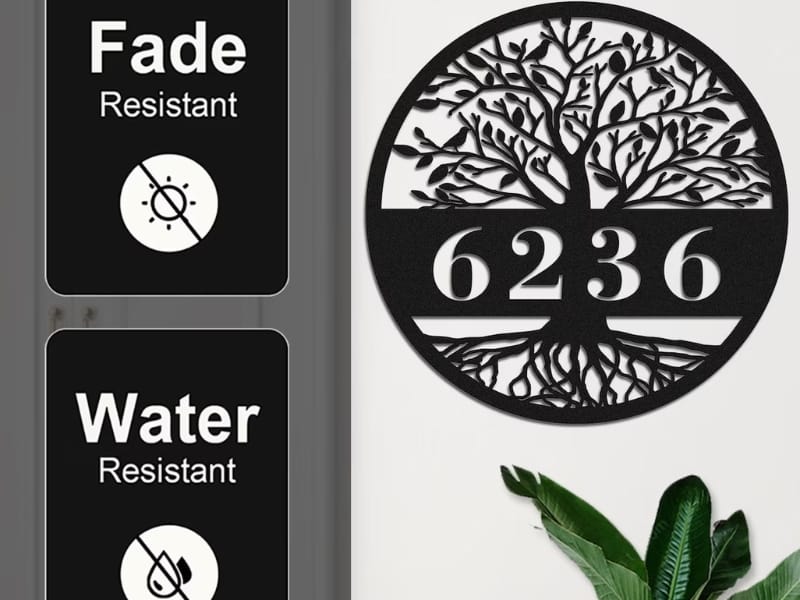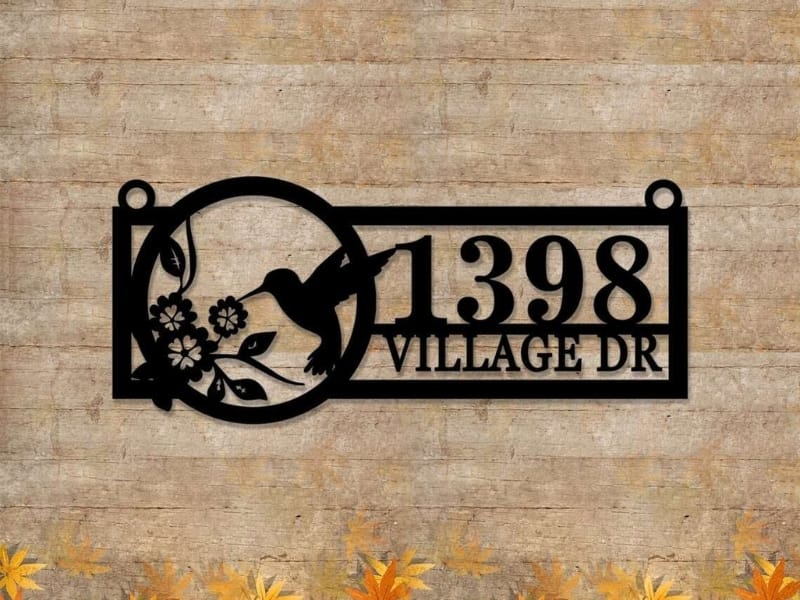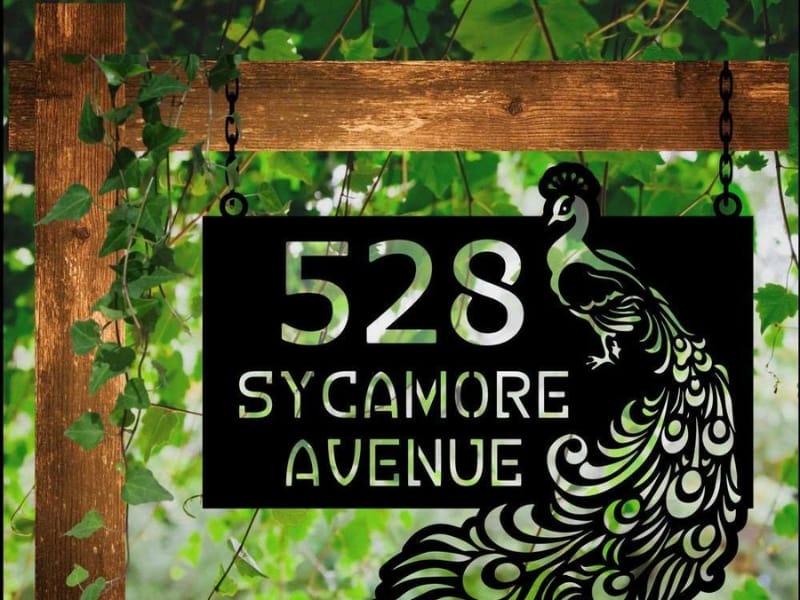News
Trending Hanging Address Sign Designs for Modern Homes
Adding a hanging address sign to your property is a simple yet impactful way to enhance visibility, curb appeal, and style. Whether you live in a suburban home, a farmhouse, or a modern residence, choosing the right design and placement for your hanging address sign can make your entrance more welcoming and functional. In this guide, we’ll walk you through the essential aspects of selecting, installing, and maintaining the perfect address sign for your home.
Best Placement & Height for Visibility
Proper placement of your hanging address sign ensures it can be seen clearly from the street, especially by guests, delivery drivers, or emergency responders. Ideally, place the sign:
- Near the main entryway, porch, gate, or mailbox.
- At an eye-level height, typically between 4.5 to 5.5 feet from the ground.
- Facing the direction of oncoming traffic for maximum visibility.
Avoid placing signs behind foliage or architectural obstructions that might hinder visibility from the road.
Choosing the Right Style & Size
When choosing a hanging address sign, style and size should reflect your home’s aesthetics while meeting practical needs for visibility and durability.
Font & Contrast
Readability is paramount. Select a bold, sans-serif or serif font with large lettering. Contrast is crucial—light text on a dark background or vice versa improves legibility, especially from a distance or at night.
Material Options
Common materials include:
- Metal (Aluminum, Steel, Iron): Durable, weather-resistant, and suitable for modern or industrial homes.
- Wood: Offers rustic charm but requires sealing or painting to resist moisture.
- Acrylic or PVC: Lightweight, affordable, and resistant to fading.
- Slate or Stone: Ideal for traditional homes; very durable but heavier.

Size Guidelines
An address sign must be visible from the street without being obtrusive. When in doubt, choose slightly larger dimensions to ensure clarity. Here’s a general guide based on placement:
- Small signs (12”–16” wide): Suitable for hanging under porch lights, on gates, or close to front doors.
- Medium signs (18”–24” wide): Ideal for fences, mailbox posts, or garden brackets; these offer a good balance between visibility and design.
- Large signs (24”–36” wide): Necessary for properties with long driveways or larger yards. They ensure the address is legible from a vehicle or public road.
If your home is set back from the street or partially obscured by trees or shrubs, consider a double-sided hanging sign mounted on a post near the entrance. This allows visibility from both directions and compensates for limited sightlines.
Mounting & Hanging Methods
When installing a hanging address sign, the choice of mounting method is just as important as the sign’s design. The installation not only affects how well the sign can be seen, but also how it complements your home’s exterior architecture. Different mounting methods suit different structural conditions, such as siding, porch beams, garden posts, or fences..
Wall Mount or Siding
Mounting your hanging address sign directly onto your home’s exterior wall or siding is a clean and space-efficient option. It’s especially suitable for homes with small front yards, townhouses, or those aiming for a minimalist look near entryways or garages.
To ensure a secure and lasting installation, use weatherproof screws or siding clips, depending on your exterior material. Always make sure the mounting surface is flat, clean, and dry before attaching the sign to avoid slippage or damage over time.

Post or Bracket Hanging
A decorative post or hanging bracket can be installed near the driveway or at the front walkway:
- Choose rust-resistant brackets with ornamental hooks.
- Use a double-sided sign for visibility from both directions.
Under Porch Roof or Beam
Hanging your address sign from a covered porch adds charm and protects it from weather exposure. Use metal eye hooks or ceiling mounts for secure attachment to beams. Suspend the sign with durable chains or coated cables, matching the style of your home.
Make sure there’s enough clearance so the sign doesn’t block walkways, doors, or lights. This method is perfect for homes with spacious porches and adds a welcoming, balanced look to your entryway.
Installation Instructions (Step-by-Step)
Installing your hanging address sign properly is essential to ensure stability, visibility, and a clean appearance. Whether you choose a quality sign from dinozozo or another trusted brand, following these steps when mounting it on a wall, beam, or post will help you achieve a professional and secure result.
Measure and Mark Positions
Start by determining the exact placement for your address hanging sign. Use a measuring tape to locate the center point or ideal alignment relative to your porch, driveway, or entryway.
Lightly mark these positions with a pencil or chalk. For maximum visibility, make sure the area is not blocked by shrubs, lighting fixtures, or architectural elements—your address sign hanging should be easily seen from the street for guests and deliveries alike.
Pre-Drill Holes
After marking your mounting points, select a drill bit that suits your surface type. Use a masonry bit for brick or concrete walls, and a wood bit for posts or beams. Creating pilot holes reduces the risk of splitting materials and ensures that your hanging address plaques will be properly aligned and easy to secure.

Insert Anchors or Hooks
Depending on the material, you may need to insert wall anchors or toggle bolts—especially on drywall or masonry surfaces. These anchors help distribute the weight and prevent screws from loosening over time. For wooden structures, heavy-duty hooks or lag screws are usually sufficient to hold metal hanging address signs or other heavier designs in place.
Align with Level Tool
Before final attachment, use a level to confirm your address sign hanging is perfectly straight. This step is particularly important with metal hanging address sign styles, where even slight misalignment can be noticeable. Proper leveling not only improves aesthetics but also reduces stress on the mounting hardware.
Secure Sign and Test Stability
With everything properly aligned, tighten your screws or hooks, then hang your sign securely. Whether using chains, rope, or a fixed mount, give the sign a gentle shake to test its stability.
This is especially important for hanging metal address signs, which can be heavier and more prone to swaying. Ensure suspension lines are balanced in length to prevent tilting and maintain a professional finish.
Maintenance & Durability Tips
To keep your hanging address sign looking sharp and functioning well over time, regular maintenance is essential—especially if it’s exposed to outdoor elements year-round. With the right care, your sign can maintain its visual appeal and structural integrity for many years.
Begin by cleaning the sign regularly to remove dirt, dust, bird droppings, and other debris. A soft cloth or sponge and mild soap mixed with water are usually sufficient. Avoid abrasive cleaners or harsh chemicals, especially on painted or coated surfaces, as they can wear down the finish and reduce the lifespan of your sign.

Every few months, inspect all mounting hardware such as hooks, screws, chains, or brackets. Exposure to moisture and fluctuating temperatures can cause rust, corrosion, or loosening over time. Tighten any hardware that has shifted, and replace rusted components promptly to prevent structural issues or safety risks.
For wooden signs, apply a fresh coat of sealant or exterior-grade paint at least once a year. This helps protect against UV damage, moisture infiltration, and warping. Signs made from cedar, redwood, or pressure-treated wood are more resistant to decay, but still benefit from periodic sealing to preserve their color and texture.
In regions prone to severe weather, consider removing lightweight or hanging signs during heavy storms, strong winds, or snow events. Signs that swing excessively in the wind may suffer from wear on their hardware or even fall, causing damage to nearby surfaces.
Finally, whether your sign is made of metal, wood, acrylic, or composite, using UV- and weather-resistant finishes will dramatically improve its durability. Powder coating, marine-grade varnishes, and specialized outdoor paints provide an added layer of defense against rain, sun, humidity, and seasonal temperature changes.
By incorporating these maintenance practices into your routine, you’ll protect your investment and ensure that your hanging address sign continues to add charm and function to your home’s exterior for years to come.

Frequently Asked Questions (FAQ)
Choosing, installing, and maintaining a hanging address sign often raises practical concerns—especially when dealing with different home exteriors, climates, or mounting methods. Below are answers to some of the most common questions homeowners have, helping you make informed decisions with confidence.
Can I hang without drilling on siding?
Yes, siding clips or adhesive hooks rated for outdoor use can support lightweight signs without drilling. However, they may not hold well in extreme weather conditions.
What’s the best material for windy or rainy climates?
Powder-coated metal or composite PVC signs perform best in harsh weather. They resist rust, warping, and fading better than untreated wood.
How can I stop signs from swinging in the wind?
Use stabilizing cables or mounting brackets at the base. Alternatively, choose a fixed mount rather than a hanging design if wind is a major concern.
Do I need permission to hang signs outdoors?
In most residential areas, no. However, check with your local HOA or municipality if you live in a regulated community or historical zone.
Conclusion
A hanging address sign not only serves a practical function but also adds a touch of personality and charm to your home’s exterior. By choosing the right style, placement, and materials, and following proper installation and care tips, you can ensure your sign remains a standout feature for years. Whether you’re upgrading curb appeal or simply making your house easier to locate, the right address sign makes all the difference.


